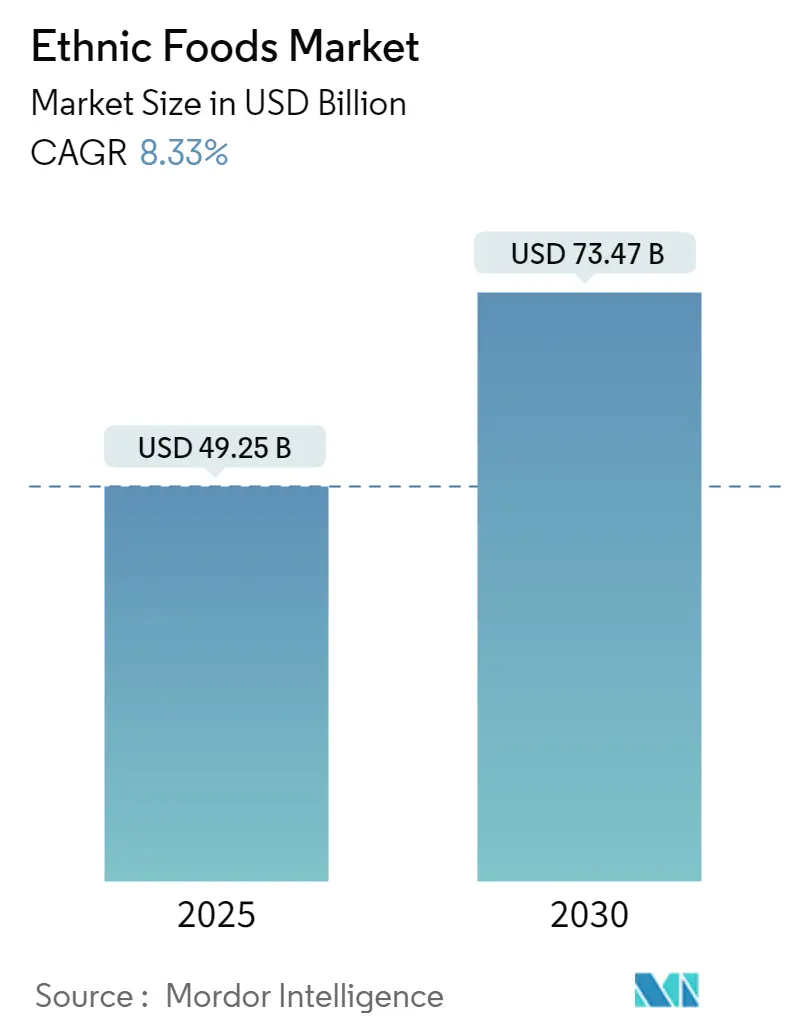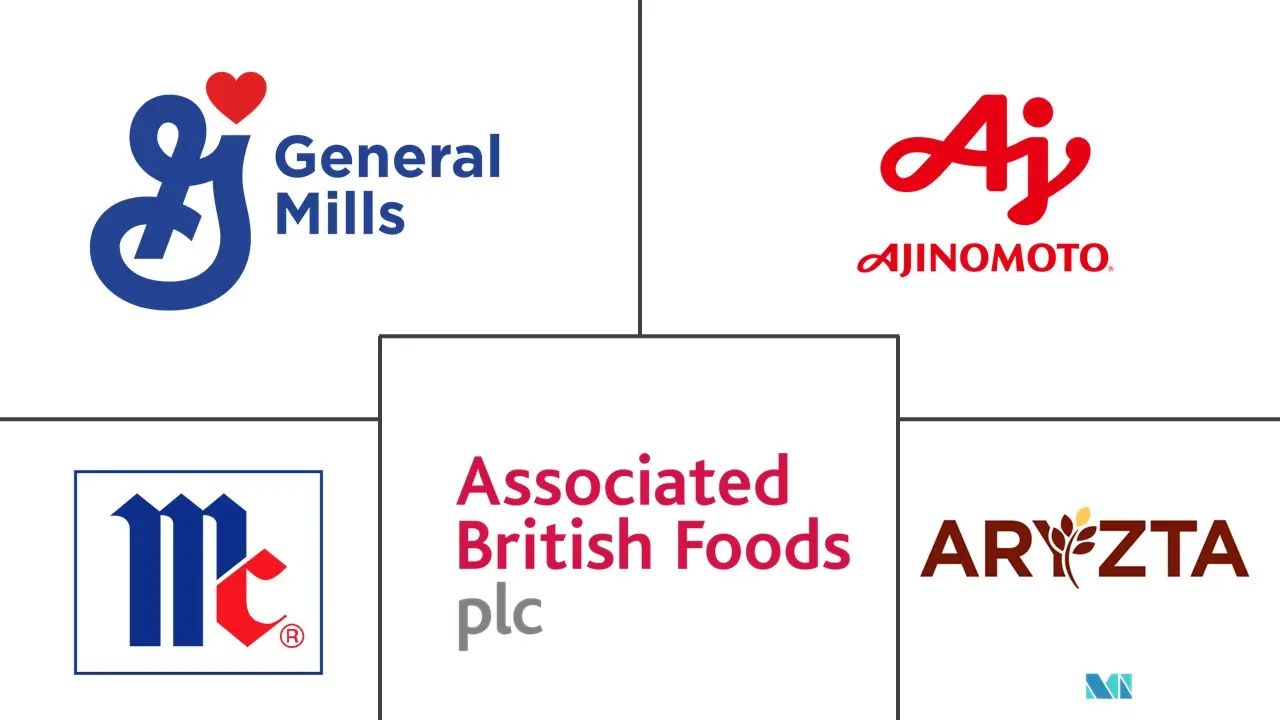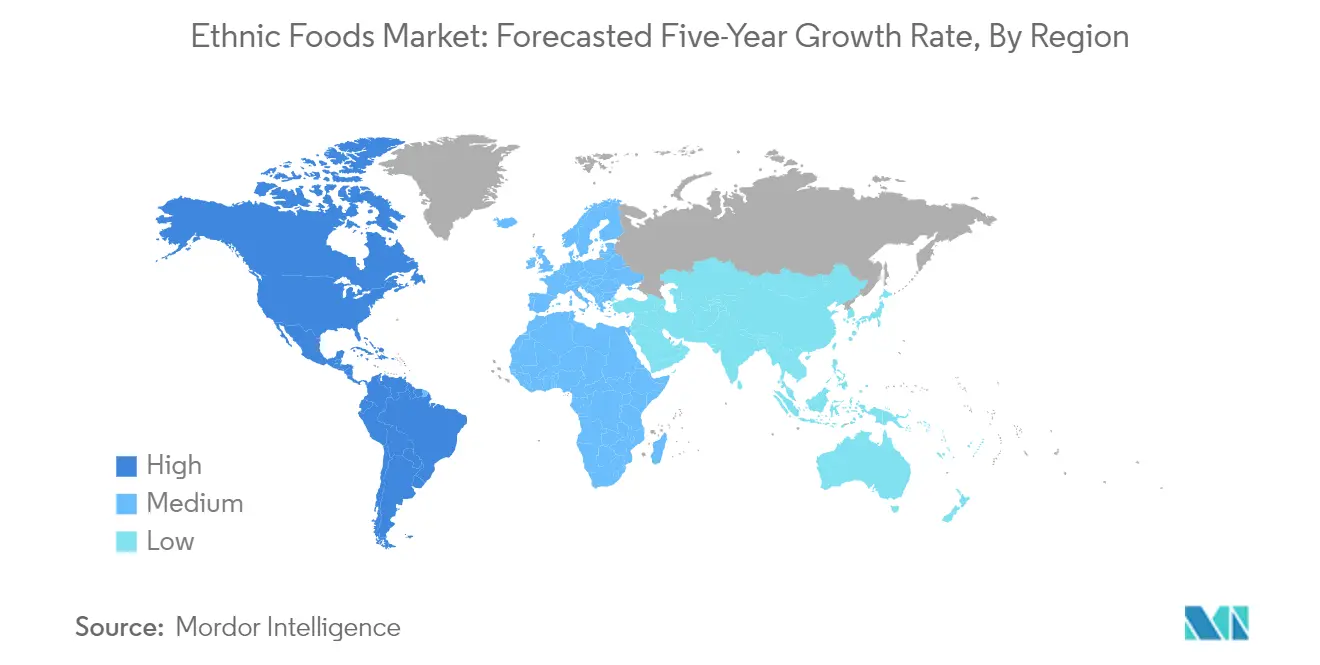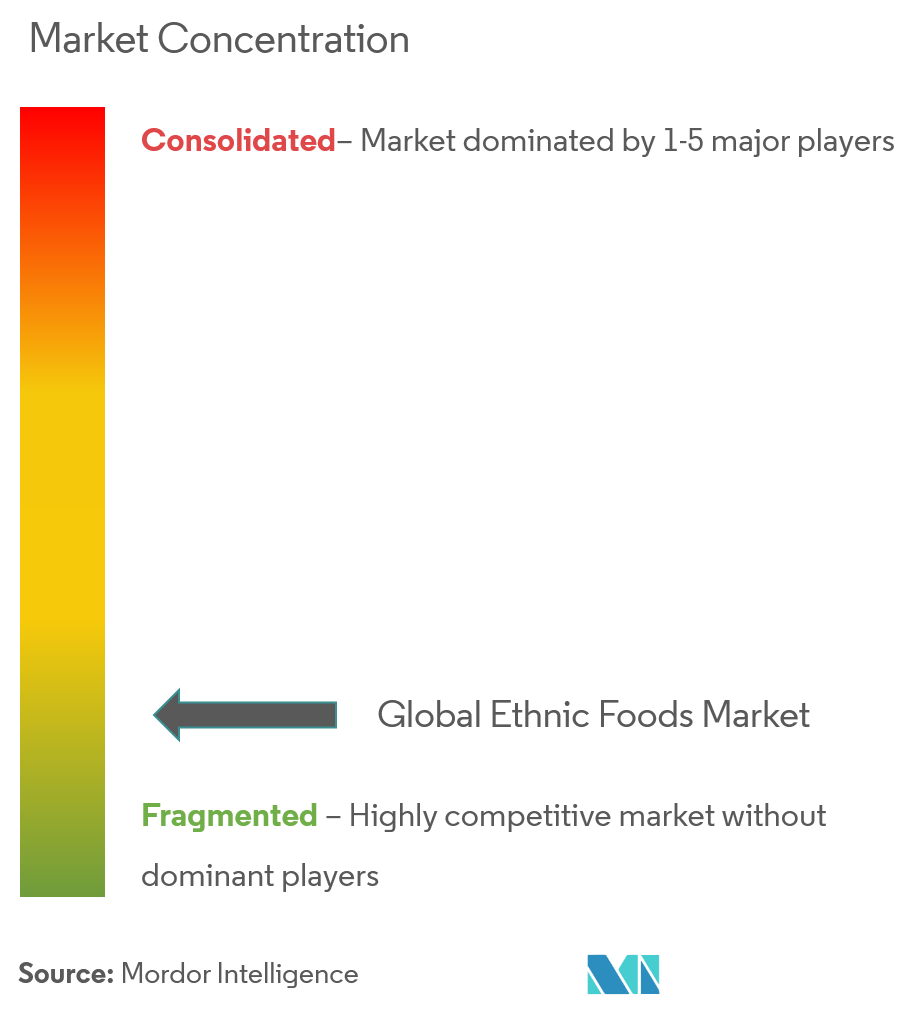
| Study Period | 2019 - 2030 |
| Market Size (2025) | USD 49.25 Billion |
| Market Size (2030) | USD 73.47 Billion |
| CAGR (2025 - 2030) | 8.33 % |
| Fastest Growing Market | Europe |
| Largest Market | North America |
| Market Concentration | Low |
Major Players
*Disclaimer: Major Players sorted in no particular order |
Ethnic Food Market Analysis
The Ethnic Foods Market size is estimated at USD 49.25 billion in 2025, and is expected to reach USD 73.47 billion by 2030, at a CAGR of 8.33% during the forecast period (2025-2030).
The global ethnic foods landscape is being significantly shaped by changing demographics and immigration patterns across major economies. The United States, as a prime example, has witnessed substantial Asian immigration, with over 14.1 million Asian immigrants residing in the country, representing a diverse mix from Southeastern Asia, South Central Asia, and Eastern Asia. This demographic shift has led to a transformation in food consumption patterns, with consumers increasingly seeking authentic ethnic cuisines and flavors. The rising immigrant population has also catalyzed the establishment of specialized ethnic food companies and stores, making diverse cultural cuisines more accessible to mainstream consumers.
Consumer preferences are evolving rapidly, driven by increased exposure to global foods through social media, international travel, and multicultural influences. Recent consumer studies in European markets highlight this trend, with traditional Asian cuisines like Chinese and Japanese, along with Mexican cuisine, gaining significant popularity among consumers. The younger generation, particularly millennials, is pushing for more diverse food experiences and is more likely to share their ethnic food experiences on social media, creating a ripple effect in popularizing various cuisines and driving ethnic food market growth.
The retail landscape for international foods is undergoing significant transformation, with major retailers expanding their ethnic food sections and offerings. Large-scale retailers are increasingly dedicating specific aisles to ethnic foods and investing in private label ethnic food products to capture the growing market opportunity. The rise of specialized ethnic food stores and the expansion of mainstream retailers into ethnic food categories has created a more competitive and diverse market environment, offering consumers greater access to authentic international cuisines.
Major manufacturers are making substantial investments in production capabilities and expanding their ethnic food portfolios through strategic acquisitions and new product launches. For instance, Paulig's recent EUR 45 million investment in a new tortilla factory in Roeselare demonstrates the industry's commitment to meeting growing demand. Additionally, the company's acquisition of Spain-based Liven to strengthen its Tex-Mex business in Europe illustrates the strategic moves manufacturers are making to capitalize on the growing ethnic foods market. These investments are accompanied by innovations in product formulations, packaging, and marketing strategies to appeal to both traditional ethnic food consumers and mainstream audiences seeking new culinary experiences.
Ethnic Food Market Trends
Prominence of Asian Ethnic Food Products Due to Increasing Presence of Immigrants from Asian Countries
The increasing presence of immigrants from Asian countries has fundamentally transformed the Asian foods market across major markets globally. According to recent immigration data, Asian immigrants represented 47% of total immigrants to the United States in 2021, making them the fastest-growing immigrant population. This demographic shift has created a robust demand for authentic Asian foods, with consumers seeking traditional flavors from regions like Southeast Asia, East Asia, and South Asia. The cultural influence extends beyond the immigrant population, as native consumers increasingly embrace Asian cuisines, leading to a broader acceptance and demand for authentic Asian food products.
The retail landscape has evolved significantly to accommodate this growing demand, with Asian retail chains expanding their presence in major markets. Major retailers are dedicating specific aisles to Asian cuisines and increasing the visibility of Asian food products on their shelves. For instance, Korean chain H-Mart has expanded to multiple locations across different states, offering imported Korean and other Asian packaged goods, prepared foods, and general merchandise. This retail expansion has been complemented by product innovations from major food manufacturers, such as CJ Foods' launch of new frozen Asian ready meals under its "Bibigo" brand, including Korean-style crunchy chicken and Korean-style fried rice varieties, demonstrating the industry's response to growing consumer interest in authentic Asian flavors.
Surge in Demand for Convenience Ethnic Food Products
The increasing demand for convenience ethnic food products is driven by significant changes in social and economic patterns, evolving meal preferences, and the desire to experience diverse cuisines. Modern consumers, particularly working professionals and millennials, are seeking ethnic food options that offer quick preparation times while maintaining authentic flavors. This trend is particularly evident in the rising popularity of ready-to-eat meals, instant formats, and ethnic frozen foods concepts that combine convenience with traditional taste profiles. The convenience factor has become crucial as consumers allocate less time for traditional grocery shopping and meal preparation, leading to increased adoption of packaged ethnic cuisine products.
The influence of social media and digital platforms has significantly amplified this trend, with millennials actively sharing their ethnic food experiences and influencing their followers' food choices. Retailers and manufacturers have responded by expanding their convenience-oriented ethnic food offerings across various formats, including ready meals, ready-to-heat appetizers, gravies, snacks, and other convenience food products. Distribution channels have also evolved, with department stores, supermarkets, specialty retailers, and online platforms like Amazon, ASDA, and Sainsbury's offering an extensive range of convenient ethnic food options. Mexican, Chinese, and Indian ethnic food products dominate this segment, while Thai, Korean, Vietnamese, Mediterranean, and Japanese ethnic food products are gaining significant traction in the convenience category.
Segment Analysis: By Distribution Channel
Supermarkets/Hypermarkets Segment in Ethnic Foods Market
Supermarkets and hypermarkets continue to dominate the ethnic grocery market, commanding approximately 55% of the total market share in 2024. This channel's prominence is attributed to its ability to offer a wide assortment of ethnic food products under one roof, providing consumers with extensive choices across various cuisines, including Asian, Mediterranean, Mexican, and other international flavors. Major retail chains have been expanding their ethnic food sections with dedicated aisles that showcase products from different cultures, making it easier for consumers to explore and purchase authentic international ingredients and ready-to-eat meals. The segment's strength is further reinforced by the increasing trend of retailers developing their own private label ethnic food products, offering consumers more affordable options while maintaining quality and authenticity.

Online Retail Segment in Ethnic Foods Market
The online retail channel is emerging as the most dynamic segment in the ethnic foods market, projected to grow at approximately 10% during 2024-2029. This remarkable growth is driven by the increasing consumer preference for convenient shopping experiences and the expanding reach of e-commerce platforms specializing in ethnic food products. Online retailers are leveraging advanced technologies to improve the shopping experience, offering detailed product information, recipe suggestions, and cooking instructions. The segment's growth is further accelerated by the rising number of specialty online ethnic food marketplaces that provide authentic international products, often difficult to find in traditional retail stores. These platforms are also implementing innovative delivery solutions and subscription models to enhance customer convenience and loyalty, contributing significantly to the international grocery market.
Remaining Segments in Distribution Channel
The convenience stores and other distribution channels segments continue to play vital roles in the specialty foods market ecosystem. Convenience stores are adapting to changing consumer preferences by expanding their ethnic food offerings, particularly in ready-to-eat meals and snacks categories. The other distribution channels, including specialty ethnic food stores, food service providers, and traditional markets, contribute significantly by offering unique and authentic products that might not be available through mainstream retail channels. These segments are particularly important in serving specific ethnic communities and food enthusiasts seeking authentic international ingredients and specialty items. Both channels are evolving their business models to incorporate digital technologies and improved customer service to maintain their competitive edge in the market, thereby enhancing the ethnic food service landscape.
Ethnic Foods Market Geography Segment Analysis
Ethnic Foods Market in North America
The North American ethnic foods market demonstrates robust growth driven by increasing multicultural populations and evolving consumer preferences for diverse cuisines. The United States leads the regional market, followed by Canada and Mexico, with each country contributing uniquely to the market dynamics. The region's growth is supported by well-established retail infrastructure, including supermarket chains and specialty stores that offer extensive international grocery market selections. The presence of major market players and their continuous product innovations, particularly in Mexican, Asian foods, and Mediterranean foods cuisines, has significantly shaped the market landscape.

Ethnic Foods Market in United States
The United States dominates the North American ethnic foods market, holding approximately 71% market share in 2024. As the world's largest economy with a wealthy population demonstrating high spending ability on multiple cuisines, the US market is characterized by diverse ethnic food offerings including Chinese, Mexican, Italian, Greek, French, Thai, Spanish, and Indian cuisines. The country's multicultural population, consisting of immigrants who have brought their authentic cuisines, drives market growth. The Mediterranean foods diet has found significant traction in packaged goods, while Asian foods continue to gain popularity due to the rising Asian-American population and increased availability of Asian food ingredients.
Ethnic Foods Market in Canada
Canada emerges as the fastest-growing market in North America, with a projected growth rate of approximately 12% during 2024-2029. The country's ethnic food landscape is enriched by its diverse population, with over 250 ethnic origins and ancestries represented among Canadians. South and Southeast Asian immigrants contribute significantly to market growth, comprising about a third of Canada's immigrant numbers annually. Canadian consumers show keen interest in experiencing dishes across cultures, particularly Chinese, Thai, Mexican, and Italian cuisines. The market growth is further supported by expanding retail channels and increasing consumer willingness to experiment with international flavors.
Ethnic Foods Market in Europe
The European ethnic foods market showcases significant diversity, influenced by the region's multicultural population and increasing immigration rates. The United Kingdom leads the market, followed by Germany, France, Spain, Italy, and Russia. The region's market is characterized by strong demand for Asian foods, Mediterranean foods, and Latin American foods, with supermarket chains actively expanding their ethnic food offerings. The market benefits from well-developed distribution networks and increasing consumer awareness about international cuisines.
Ethnic Foods Market in United Kingdom
The United Kingdom maintains its position as the largest ethnic foods market in Europe, commanding approximately 41% of the regional market share in 2024. The country's market is driven by one of the largest populations of migrants in Europe, with significant communities from India, Poland, and Pakistan. The strong presence of Asian cuisines, particularly Indian and Chinese, has transformed the UK's food landscape. The market is further supported by extensive retail networks and increasing consumer demand for authentic international flavors.
Ethnic Foods Market in Germany
Germany represents the fastest-growing major market in Europe, with an expected growth rate of approximately 9% during 2024-2029. The country's ethnic food market benefits from its large multicultural population, with about 26% of the total population having a migration background. The majority of people with migration backgrounds originate from other European countries, while a significant portion comes from Asia, particularly the Middle East. The market growth is driven by increasing international food retailers and expanding distribution channels for ethnic food products.
Ethnic Foods Market in Asia-Pacific
The Asia-Pacific ethnic foods market demonstrates unique characteristics, with significant cross-cultural influences shaping consumer preferences. The region shows strong demand for various international cuisines, while also exporting its own ethnic food products globally. China leads the regional market, followed by Australia, India, and Japan. The market is characterized by increasing westernization of food habits, growing expatriate populations, and rising disposable incomes.
Ethnic Foods Market in China
China maintains its position as the largest ethnic foods market in the Asia-Pacific region. The market benefits from improved standards of living and increasing consumer willingness to spend on ethnic foods. Chinese consumers show growing interest in international cuisines, particularly those from South Korea, Japan, and Taiwan. The presence of international supermarket chains and their partnerships with global brands has enhanced the availability of ethnic food products in the country.
Ethnic Foods Market in India
India emerges as the fastest-growing market in the Asia-Pacific region. The market growth is driven by increasing foreign tourism, innovations in the packaged food sector, and changing food habits among young consumers with rising disposable incomes. The country shows particular interest in Western cuisines, with Italian food gaining significant popularity alongside the traditionally popular Chinese cuisine. The market is further supported by expanding specialty and international food aisles in supermarkets.
Ethnic Foods Market in Rest of the World
The Rest of the World region, encompassing South America and the Middle East & Africa, presents unique opportunities in the ethnic foods market. In South America, Asian foods-Latin American fusion cuisine leads market growth, with significant influence from Japanese and other Asian cuisines, particularly in countries like Brazil and Peru. The Middle East and Africa region shows increasing acceptance of international cuisines, supported by growing expatriate populations and tourism. South America represents the larger market segment, while the Middle East and Africa region demonstrates faster growth potential, driven by changing consumer preferences and increasing exposure to Middle Eastern foods and African foods. Additionally, the demand for halal foods and kosher foods is rising, reflecting diverse consumer bases.
Ethnic Food Industry Overview
Top Companies in Ethnic Foods Market
The global ethnic foods market features prominent players like Ajinomoto Co. Inc., McCormick & Company Inc., Associated British Foods PLC, General Mills Inc., and Orkla ASA leading the competitive landscape. Companies are heavily investing in product innovation, particularly focusing on authentic flavors, convenient formats, and health-conscious offerings to meet evolving consumer preferences. Operational agility has become paramount as firms adapt their supply chains and distribution networks to serve both traditional retail and growing e-commerce channels. Strategic partnerships with regional specialists and foodservice operators have emerged as a key trend to penetrate new markets and expand product reach. Companies are also emphasizing sustainability initiatives and clean-label products while expanding their manufacturing capabilities in key growth markets to maintain a competitive advantage. The global food industry is witnessing these shifts as companies strive to enhance their market positioning.
Fragmented Market with Strong Regional Players
The ethnic foods market exhibits a fragmented structure characterized by the presence of both global conglomerates and specialized regional players. Global companies leverage their extensive distribution networks, research capabilities, and brand portfolios to maintain market leadership, while regional players capitalize on their deep understanding of local tastes and preferences. The market demonstrates moderate consolidation in mature regions like North America and Europe, where established players dominate through their diverse product portfolios and strong retail relationships. However, emerging markets remain highly fragmented with numerous local players serving specific ethnic cuisine segments.
Merger and acquisition activity in the market has been steadily increasing as larger companies seek to expand their ethnic food portfolios and geographical presence. Companies are particularly targeting specialized ethnic food companies with a strong regional presence or unique product offerings to enhance their market position. The industry has also witnessed strategic partnerships between global players and local manufacturers to develop authentic products and leverage established distribution networks. This trend of consolidation is expected to continue as companies seek to capture growing consumer interest in diverse ethnic cuisines and expand their presence in emerging markets.
Innovation and Authenticity Drive Market Success
Success in the ethnic foods market increasingly depends on companies' ability to balance authenticity with convenience while maintaining product quality and competitive pricing. Market incumbents must focus on continuous product innovation, particularly in developing clean-label products and convenient formats that preserve traditional flavors. Investment in research and development, sustainable sourcing practices, and efficient production processes has become crucial for maintaining market share. Companies must also strengthen their digital presence and direct-to-consumer channels while maintaining strong relationships with traditional retail partners.
For new entrants and smaller players, success lies in identifying and serving niche ethnic cuisine segments with authentic, innovative products. Building strong regional distribution networks, leveraging e-commerce platforms, and developing strategic partnerships with established players can help contenders gain market share. The relatively low risk of substitution due to unique ethnic flavors and recipes provides opportunities for differentiation, though companies must navigate varying food safety regulations and certification requirements across regions. Understanding and adapting to local taste preferences while maintaining authenticity remains crucial for long-term success in this dynamic market. The specialty foods industry is particularly poised to benefit from these trends as it aligns with consumer demand for unique and diverse offerings.
Ethnic Food Market Leaders
-
Ajinomoto Co. Inc.
-
McCormick & Company Inc.
-
General Mills, Inc.
-
Associated British Foods PLC
-
Orkla ASA
- *Disclaimer: Major Players sorted in no particular order

Ethnic Food Market News
- February 2022: Patak launched its "Patak's Makes Perfect" TV advertisement in collaboration with a creative advertising agency, BMB. With this new advertisement, the company aimed to strengthen its market presence in the ethnic foods retail space.
- February 2022: Aryzta, which operates the Cuisine de France brand, acquired the bakery, equipment, and the corresponding land of co-manufacturer De-Luxe Food Services from Envictus International Holdings Limited. This expansion strengthened Aryzta's relevant position in bakery products in Malaysia.
- January 2022: Paulig, which has two production sites for tortillas, dinner kits, and chips in Belgium (Roeselare) and is currently building a third production facility, acquired the innovative Spain-based company, Liven. With this acquisition, Paulig hoped to expand its Tex-Mex and snacking activities in Europe.
- October 2021: General Mills expanded its Old El Paso range by introducing new flavored taco shells in collaboration with crisp brand Takis in the United States. The company's latest product is inspired by Takis 'Fuego' crisp flavor and was named 'Hot Chili Pepper and Lime-Flavored Stand'N Stuff Taco Shells.' The product was exclusively available through Walmart stores.
Ethnic Food Market Report - Table of Contents
1. INTRODUCTION
- 1.1 Study Assumptions and Market Definition
- 1.2 Scope of the Study
2. RESEARCH METHODOLOGY
3. EXECUTIVE SUMMARY
4. MARKET DYNAMICS
- 4.1 Market Drivers
- 4.2 Market Restraints
-
4.3 Porter's Five Forces Analysis
- 4.3.1 Bargaining Power of Suppliers
- 4.3.2 Bargaining Power of Buyers
- 4.3.3 Threat of New Entrants
- 4.3.4 Threat of Substitute Products
- 4.3.5 Intensity of Competitive Rivalry
5. MARKET SEGMENTATION
-
5.1 Distribution Channel
- 5.1.1 Supermarkets/Hypermarkets
- 5.1.2 Convenience Stores
- 5.1.3 Online Retail Channels
- 5.1.4 Other Distribution Channels
-
5.2 Geography
- 5.2.1 North America
- 5.2.1.1 United States
- 5.2.1.2 Canada
- 5.2.1.3 Mexico
- 5.2.1.4 Rest of North America
- 5.2.2 Europe
- 5.2.2.1 United Kingdom
- 5.2.2.2 Germany
- 5.2.2.3 Spain
- 5.2.2.4 France
- 5.2.2.5 Italy
- 5.2.2.6 Russia
- 5.2.2.7 Rest of Europe
- 5.2.3 Asia-Pacific
- 5.2.3.1 China
- 5.2.3.2 Japan
- 5.2.3.3 India
- 5.2.3.4 Australia
- 5.2.3.5 Rest of Asia-Pacific
- 5.2.4 Rest of the World
- 5.2.4.1 South America
- 5.2.4.2 Middle East & Africa
6. COMPETITIVE LANDSCAPE
- 6.1 Most Active Companies
- 6.2 Strategies Adopted by Key Players
- 6.3 Market Share Analysis
-
6.4 Company Profiles
- 6.4.1 Ajinomoto Co. Inc.
- 6.4.2 McCormick & Company Inc.
- 6.4.3 Associated British Foods PLC
- 6.4.4 General Mills Inc. (Old El Paso)
- 6.4.5 Orkla ASA
- 6.4.6 ARYZTA AG
- 6.4.7 Paulig Ltd.
- 6.4.8 Asli Fine Foods
- 6.4.9 Capital Foods (Ching's Secret)
- 6.4.10 Charlie Bigham
- 6.4.11 The Spice Tailor
- 6.4.12 Quality Ethnic Foods Inc.
- *List Not Exhaustive
7. MARKET OPPORTUNITIES AND FUTURE TRENDS
Ethnic Food Industry Segmentation
Ethnic food refers to a wide variety of packaged foodstuffs that can be identified by the public mind as coming from a foreign source.
The ethnic foods market is segmented by distribution channel into hypermarkets/supermarkets, convenience stores, online stores, and other distribution channels. By geography, the market is segmented into North America, Europe, Asia-Pacific, and Rest of the World. For each segment, the market sizing and forecasts have been done in value terms (USD million).
| Distribution Channel | Supermarkets/Hypermarkets | ||
| Convenience Stores | |||
| Online Retail Channels | |||
| Other Distribution Channels | |||
| Geography | North America | United States | |
| Canada | |||
| Mexico | |||
| Rest of North America | |||
| Europe | United Kingdom | ||
| Germany | |||
| Spain | |||
| France | |||
| Italy | |||
| Russia | |||
| Rest of Europe | |||
| Asia-Pacific | China | ||
| Japan | |||
| India | |||
| Australia | |||
| Rest of Asia-Pacific | |||
| Rest of the World | South America | ||
| Middle East & Africa | |||
Ethnic Food Market Research FAQs
How big is the Ethnic Foods Market?
The Ethnic Foods Market size is expected to reach USD 49.25 billion in 2025 and grow at a CAGR of 8.33% to reach USD 73.47 billion by 2030.
What is the current Ethnic Foods Market size?
In 2025, the Ethnic Foods Market size is expected to reach USD 49.25 billion.
Who are the key players in Ethnic Foods Market?
Ajinomoto Co. Inc., McCormick & Company Inc., General Mills, Inc., Associated British Foods PLC and Orkla ASA are the major companies operating in the Ethnic Foods Market.
Which is the fastest growing region in Ethnic Foods Market?
Europe is estimated to grow at the highest CAGR over the forecast period (2025-2030).
Which region has the biggest share in Ethnic Foods Market?
In 2025, the North America accounts for the largest market share in Ethnic Foods Market.
What years does this Ethnic Foods Market cover, and what was the market size in 2024?
In 2024, the Ethnic Foods Market size was estimated at USD 45.15 billion. The report covers the Ethnic Foods Market historical market size for years: 2019, 2020, 2021, 2022, 2023 and 2024. The report also forecasts the Ethnic Foods Market size for years: 2025, 2026, 2027, 2028, 2029 and 2030.
Our Best Selling Reports
Ethnic Foods Market Research
Mordor Intelligence provides a comprehensive analysis of the ethnic foods market, utilizing our extensive expertise in the global food industry. Our latest report explores the diverse landscape of international foods, including segments such as Mediterranean foods, Asian foods, halal foods, and Middle Eastern foods. The analysis covers trends in traditional cuisine, the development of specialty foods, and emerging opportunities in the international grocery market. It offers detailed global food industry statistics and growth indicators across various regions and categories.
Stakeholders in the ethnic food industry can access valuable insights through our easily downloadable report PDF. The report includes an in-depth global food market outlook and projections for ethnic food market growth. It addresses crucial aspects of ethnic grocery operations, ethnic ingredients sourcing, and ethnic food service dynamics. Additionally, it analyzes global food industry trends that influence market development. Our research aids decision-making for international food companies and ethnic food companies by offering actionable intelligence on opportunities in the specialty foods market and the evolution of the cultural food market. The report is complete with detailed world food industry statistics and regional market analyses.




